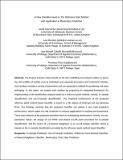Files in this item
A new classifier based on the reference point method with application in bankruptcy prediction
Item metadata
| dc.contributor.author | Ouenniche, Jamal | |
| dc.contributor.author | Bouslah, Kais | |
| dc.contributor.author | Cabello, Jose Manuel | |
| dc.contributor.author | Ruiz, Francisco | |
| dc.date.accessioned | 2018-06-21T23:32:24Z | |
| dc.date.available | 2018-06-21T23:32:24Z | |
| dc.date.issued | 2018-01-12 | |
| dc.identifier | 250454776 | |
| dc.identifier | 8e6d1286-8701-4be0-b9f8-3116c6f01a85 | |
| dc.identifier | 000452046800011 | |
| dc.identifier | 85021082530 | |
| dc.identifier.citation | Ouenniche , J , Bouslah , K , Cabello , J M & Ruiz , F 2018 , ' A new classifier based on the reference point method with application in bankruptcy prediction ' , Journal of the Operational Research Society , vol. 69 , no. 10 , pp. 1653-1660 . https://doi.org/10.1057/s41274-017-0254-z | en |
| dc.identifier.issn | 0160-5682 | |
| dc.identifier.other | ORCID: /0000-0001-8407-8929/work/82179585 | |
| dc.identifier.uri | https://hdl.handle.net/10023/14433 | |
| dc.description.abstract | The finance industry relies heavily on the risk modelling and analysis toolbox to assess the risk profiles of entities such as individual and corporate borrowers and investment vehicles. Such toolbox includes a variety of parametric and nonparametric methods for predicting risk class belonging. In this paper, we expand such toolbox by proposing an integrated framework for implementing a full classification analysis based on a reference point method, namely in-sample classification and out-of-sample classification. The empirical performance of the proposed reference point method-based classifier is tested on a UK data set of bankrupt and nonbankrupt firms. Our findings conclude that the proposed classifier can deliver a very high predictive performance, which makes it a real contender in industry applications in banking and investment. Three main features of the proposed classifier drive its outstanding performance, namely its nonparametric nature, the design of our RPM score-based cut-off point procedure for in-sample classification, and the choice of a k-nearest neighbour as an out-of-sample classifier which is trained on the in-sample classification provided by the reference point method-based classifier. | |
| dc.format.extent | 8 | |
| dc.format.extent | 359890 | |
| dc.language.iso | eng | |
| dc.relation.ispartof | Journal of the Operational Research Society | en |
| dc.subject | Bankruptcy | en |
| dc.subject | In-sample prediction | en |
| dc.subject | k-nearest neighbour classifier | en |
| dc.subject | Out-of-sample prediction | en |
| dc.subject | Reference point method classifier | en |
| dc.subject | Risk class prediction | en |
| dc.subject | HD28 Management. Industrial Management | en |
| dc.subject | Finance | en |
| dc.subject | Economics, Econometrics and Finance (miscellaneous) | en |
| dc.subject | Management Science and Operations Research | en |
| dc.subject | NDAS | en |
| dc.subject | BDC | en |
| dc.subject | R2C | en |
| dc.subject.lcc | HD28 | en |
| dc.title | A new classifier based on the reference point method with application in bankruptcy prediction | en |
| dc.type | Journal article | en |
| dc.contributor.institution | University of St Andrews. School of Management | en |
| dc.contributor.institution | University of St Andrews. Centre for the Study of Philanthropy & Public Good | en |
| dc.contributor.institution | University of St Andrews. Centre for Responsible Banking and Finance | en |
| dc.identifier.doi | https://doi.org/10.1057/s41274-017-0254-z | |
| dc.description.status | Peer reviewed | en |
| dc.date.embargoedUntil | 2018-06-21 |
This item appears in the following Collection(s)
Items in the St Andrews Research Repository are protected by copyright, with all rights reserved, unless otherwise indicated.

